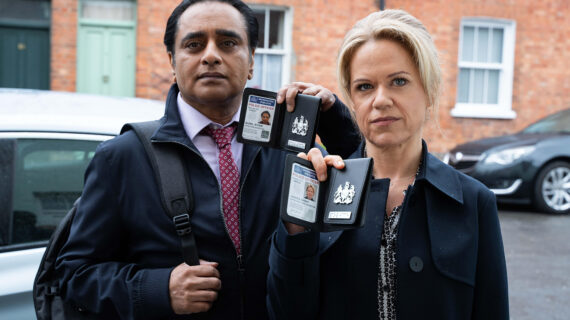– Tonight we’re very honored to have a panel led by Donna Friedsam, and she is with us to discuss healthcare access, reform, and finding equity for rural and urban communities. Donna Friedsam is a distinguished researcher at the University of Wisconsin, and health policy programs director within the University of Wisconsin Population Health Institute. She leads a team of faculty and researchers evaluating pilot and demonstration initiatives of the Wisconsin Medicaid and BadgerCare Plus coverage programs; she also oversees the UW’s Evidence-Based Health Policy Project, a partnership with the La Follette School of Public Affairs and the Wisconsin legislative council; and the Covering Wisconsin program within the UW’s School of Human Ecology. Friedsam focuses on healthcare coverage, access, financing, and the organization of delivery systems with a particular interest in how policies and programs affect low-income and vulnerable populations. She consults widely in the public and private sectors on state government programs and on reform initiatives. Her work has been widely published in both peer-reviewed journals and practice-oriented formats. State and national media outlets rely regularly on her expertise in their reporting on matters of state and federal health policy.
Tonight she is joined by Greg Nycz and Lisa Peyton-Caire. Nycz is the executive director of Family Health Center of Marshfield Incorporated, a federally-funded community health center. Nycz has been involved with the planning and operation of the Family Health Center for over 44 years, and he’s been involved with service, research and educational efforts aimed at improving the health of communities with a particular emphasis on vulnerable population groups, principally, rural and low-income populations. Over the past 15 years, he’s become increasingly involved in activities designed to address oral health disparities and access to care and outcomes. Peyton-Caire is the assistant vice president of Life, Learning and Events at Summit Credit Union, where she leads efforts on diversity and inclusion, employee wellness, financial education, community giving and events; she’s also the founder of the Foundation for Black Women’s Wellness, a Wisconsin-based nonprofit organization committed to eliminating health disparities and other barriers impacting the lives of black women. And now, please, help me give a warm welcome to Donna Friedsam, Greg Nycz, and Lisa Peyton-Caire.
[audience applauds]
– Well, good evening. I’m going to see if I know how to operate this device. I’m very pleased to be with you all, and I want to thank you for, thank the Wisconsin Academy for inviting me to speak with you all about health access for rural and urban communities, and achieving equity. I also want to thank my good friend and colleague Tim Size who’s with the Wisconsin Academy, a volunteer, I believe, with the Wisconsin Academy, and was kind enough to invite me to speak with you all. Tim is not able to be here because he is down with one of the terrible viruses that have been circulating this season, but I know that he is very committed to these issues and has been working on them for his entire career. I want to start by asking you all, who in this room has read either of these two books? So, several, although not the majority. But you may be aware though that, oh, these two books, the one of the right, Politics of Resentment, is by Katherine Cramer, a UW faculty member who has, did a lot of work interviewing people around the state, and the one left, Hillbilly Elegy, both of them exploring similar themes that became something of a dominant narrative over the last year and a half, looking at the issues around the rural dispossessed, so to speak, people who have felt that their concerns and their interests have not been well addressed, and the kinds of struggles that have been occurring, particularly in rural America, and an emerging underclass of people who have, who don’t feel that the economy has been serving them well over the last several years.
And this has been very strongly linked with the election of President Trump, and what kinds of movements that have led to that election. But I want to, in talking with you all tonight, think about this narrative that has emerged and try to come up with an alternative narrative that bridges the rural and urban divide, and let me ask you again. How many of you have read, in addition, this other book that I added to the mix here, “Evicted”? This was also one of the UW’s Big Read books in the last year, and I see many of you have read that, and that’s addressing the concerns primarily of the urban dispossessed, as I would refer to them, the urban poor, and how problems of housing and other economic challenges, and challenges around equity, and, challenges trying to keep up in a system that feels unfair, creates a feeling that you just cannot get ahead. I’m going to come back to these themes throughout my talk, but before I do that, I want to just cover some basics about what’s been going on over the last few years around coverage and access in our state, and relating that to national and state health policy. So let me start with this. As you all know, we had a major change in federal health policy over the last several years with the Affordable Care Act, or other, or you may know it as Obamacare, and I refer to it in both ways, ACA, the Affordable Care Act or Obamacare, no partisan attachments to either of those phrases. And so I’m gonna just show you what happened in Wisconsin from before the Affordable Care Act to after the Affordable Care Act, so looking at 2013 to the most recent year for which we have data, which is 2016, to try to understand first how changes in health insurance coverage have occurred in our state under this new policy regime from the federal government.
And what we know, looking at the federal data, again, for 2016, is that we have currently about 5.3% of our state’s population who are uninsured, and that’s a decline from 9.1% in 2013. So we’ve had a substantial reduction in the uninsured, about 42% reduction in the uninsured over that time, and that the uninsured decreased by about 216,000 people over the time before the Affordable Care Act to the most current date for which we have data. And you can see by this slide, I don’t know if the lights. Are people able to see the slides well from the back? You can see on this slide, each of these colors are different income categories, and it’s not terribly important which categories they are, but just to show you that each of the boxes shrunk as well as the overall bar going down in the uninsured, so you can see that the uninsured also decreased within income categories as well. And that’s good, we’d like to see uninsured decreasing across income categories. I’m not gonna go in detail about this, you’re not meant to understand all of these graphs, but just to show you that the uninsured from 2013 to 2016 actually decreased across income ranges, across age ranges, and across race and ethnicity categories. So I guess I’m walking away from there, and that’s good, ’cause I’m gonna point. And so you can see, and this is really good news, that even in all of these race and ethnicity categories, the blue bar being 2013, the red bar being 2016, we’ve seen significant declines in the uninsured from prior to Obamacare to most recent data period.
Substantial declines across the uninsured, and large declines in uninsured among persons in the lowest income groups. And in young ages, ages 18, or 19 to 25 years old, and among racial and ethnic minorities. In terms of rural and urban populations, you can see, Wisconsin’s population is about 70% non-rural, and, I’m sorry, 70%, yes, non-rural and 30% rural, but the plan selections under the Affordable Care Act is about 63% non-rural and 37% rural, so what that shows you is that rural populations are selecting, participating in Obamacare at higher rates than they are represented in the overall population. And this map shows that as well. This is a clip from the Journal Sentinel, that those counties that went for President Trump in the election also showed a higher rate of take-up of Obamacare. We also know from this, this is the article in the Journal of Rural Health, that the Medicaid expansion increased Medicaid coverage more in rural areas than in urban populations as well. So this is somewhat counter what you might expect, given the voting patterns of this population, and even given the narrative that we’ve heard about the disparities of rural and urban populations in terms of the resources being dedicated there. You can see here, I understand that the gradations aren’t great for you to be able to understand, but in terms of the uninsured rate by county 2013 to 2015, it looks the same because this mapping program, but the map, the range itself changed, so the lowest range in 2013 that they were showing is 6%, ranging up to 19.5%, if you look on that upper left-hand corner, and if you look in the right-hand corner, they go down to 3.7%, up to 17%. So significant reductions across the board in every county in the state in the last three years.
And you can see here, reductions in the uninsured rate in every county in the state, ranging from a 40% reduction to a 9% reduction over that time period. The number, and I’m gonna get through all these numbers and start telling you a story in a minute, but I just want to kinda lay the groundwork so you can understand what’s happened over the last few years. In terms of the access to health plans for people to enroll in, I know a big narrative that occurred over the last year in particular was the lack of insurance plans available, particularly in rural areas around the country, and that’s absolutely the case. It was very difficult in a number of states for them to find insurance carriers to offer Obamacare plans. We did not have as difficult a time in our state, where we are the most competitive insurance market in the country. We did see some decline in participation in insurance carriers, so where we previously had 15 insurance carriers, then we went down to 13, now we had 11 insurance carriers in this past year. That’s still a lot of insurance carriers participating in Obamacare. You can see here, this map showed for this most current year, the number of insurance carriers offering products in each of the counties throughout the state. Now, it is troubling that there’s a number of counties where there’s only one carrier, and the number of counties where there’s two, and that certainly needs to be addressed, but I will posit that there’s some counties, particularly in rural areas, where we’re not gonna be able to ever expect to have a large number of carriers offering plans in the same way that we have rural areas that only have one grocery store, or only have one hardware store.
In some places, they just simply, the population simply can’t sustain a large number of competitors in any kind of a business proposition, but that does not mean there isn’t work to be done. There certainly is. But we can also note that in Wisconsin, we’ve done better than in other states in terms of keeping carriers in the market, and for the most part, like I said, we have 11 carriers, and all of them that remain are our domestic insurance carriers, the ones that are homegrown in Wisconsin, and many of them linked to our integrated delivery systems. So with all that being set, I wanna point out to you that, apart from all these gains in insurance coverage that have occurred, Wisconsin still has and has had for decades significant shortages of health professionals to deliver healthcare. So you can have health insurance, but who’s gonna deliver the care? But even here, is this a rural versus urban problem. I want to make the point with this map that this exists not based on a rural-urban divide, but based on significant challenges in communities throughout our state. And you can see here, these are designated health professional shortage areas, which is a federal designation around the need for certain primary care providers, and you can see that these designated areas exist throughout our entire state including in Milwaukee, Racine, Kenosha, Beloit, and even, well, it’s not shown in this map, but I’ll show you, let’s see if I showed the medically underserved areas in this map, but we have a designated medically underserved area even in Madison.
These areas exist based on pockets of poverty and various other factors, not based necessarily on rurality per se. And I want to show you more about that here with dental health as well. We have significant shortages of dental professionals throughout our state in rural areas, and in Madison, Racine, Kenosha, Milwaukee, Beloit, Green Bay, and it really is not linked only to being in a rural area. Mental health, same story. You can see that we have shortages throughout our state: urban and rural areas. So before I talk a little bit more about the needs in rural and urban areas in Wisconsin, I just want to give you some baseline data about the populations in Wisconsin’s rural and urban communities. This is what we have based on just aggregate data from the most recent census. The overall population in Wisconsin’s rural areas, we have about 12% in poverty, 14% in urban areas, uninsured, about, they are identifying here, and these are certainly outdated based on, needing to update based on the Affordable Care Act, but they are identifying 14 and 15%, and with children, they’re identifying a 19% poverty rate for children and a 22% poverty rate in urban areas for children. So the point here is that, again, it’s not a rural and urban divide with regard to who has greater needs. There are needs in both geographic areas that need to be addressed. That being said, what we had in the last year, or two years, is a lot of focus on, particularly a study that was published by two researchers, Case and Deaton, that led to a lot of discussion about what was called deaths of despair, and it referred to the rising morbidity and mortality among white non-Hispanic Americans, and we saw these changes starting from the beginning of the decade, or the turn of the century really, the year 2000, and they showed how many more of these so-called deaths of despair were occurring throughout the country.
And you can see the darker areas are the death rates, and they were really focusing, and Case and Deaton were really focusing in their article about the mortality and morbidity, like I said, of white non-Hispanic Americans in midlife, and how it was increasing since the year 2000. They were focusing on drug overdoses, suicides, alcohol-related, liver mortality, particularly among those with high school degrees or less. They showed marked differences in mortality by race and education, with mortality among white non-Hispanics rising for those without a college degree, and falling for those with a college degree. And they noted that this is linked– They speculated that this is linked to progressively worsening labor market opportunities and cumulative disadvantages associated with that. And what they concluded in their writing, and I quote it here, is the stress and hopelessness faced by this population as they enter the labor market are met with bleaker prospects and lower-paying job opportunities relative the prior generation. This has led to compounding family dysfunction, poor social support, addiction, conditions that are drivers of despair deaths.
So that article was cited widely in the media, and an intense focus occurred around deaths of despair and really focusing on the needs of rural communities. And you see, this article here is one excerpt. Deaths, despair in the heartland, focus on rural health. This was an entire issue of the Journal of Public Health focusing on deaths of despair, and linking it specifically to rural health. And these are the articles they had in there. And you can see that the references were specifically to Case and Deaton and their article. And to what else, to Hillbilly Elegy. So this became the dominant narrative, that deaths of despair are about rural, and I really want to challenge that notion. And know that an alternative narrative here is that to cross this rural-urban divide, and let us think about deaths of despair being about an underclass that’s existed in this country and has been growing, and we’re noticing it perhaps more in rural areas, but there’s been this ongoing underclass that’s been struggling in urban areas for a very long time, and that they have a shared purpose and a shared need, and it’s not a matter of urban versus rural in this country. What I want to point out, and this article shows for example that rates of access to care are similar across all geographies and are linked to income and other demographic factors. This was an article looking at suburban, access to care in suburban poverty. And they found that access for the poor is substantially worse than access for non-poor across all geographies. And the large affordability gap is based on income, with substantially worse access rates for the poor than the non-poor. And they found a lot of problems regardless, again, of whether it was urban, rural, or suburban. So, note. Rates of poverty are higher in cities than in rural areas.
We have a lot of people living in poverty in suburbs, and a lot of people living in poverty in urban and in rural areas. Overall, the un-insurance rate may be lower in suburban areas than in cities and in rural areas, but nearly 40% of the uninsured live in the suburbs, turns out. So we can’t make these generalizations about the needs being more in certain geographies than in other geographies. It’s not about where people are living. It’s about their socioeconomic status that’s where the need lies. And the aggregate data that we’re looking at with regard to geography is creating vague generalizations that are missing what’s really going on for the population. You can have very well-off people in any geography that are doing very well with regard to their healthcare access or their health experience. And then there’s the underclass that have shared experience regardless of where they’re living. And relatedly, we know that blacks still have significantly higher fatality rates than white Americans, and the disparities remain entrenched, regardless of the data we’re seeing about increasing white mortality. So here, with this alternative narrative, I’m going to move into our next speaker, Greg Nycz, by pointing out a few, leave you with a few other thoughts. Healthcare access is about a range of issues. Geographic barriers are one issue. Financial barriers, cultural and linguistic barriers, those are all important things to consider when understanding access to care. Transportation and geographic barriers exist in rural areas and in urban areas.
Availability of care is a challenge for mental health, dental care, primary care and hospitals, but it’s very important for us to consider how differences in income levels within geographies may affect access to care, and we need to consider to disaggregate by geography in our data analysis in order to identify, monitor, and attempt to eliminate health disparities among these populations. We’re not gonna get there if we look at these aggregate data and think, now we need to focus on rural at the expense of other geographies. You can see here, contrary to the thought that deaths of despair are a rural problem. 2016 drug poisoning in Wisconsin. That does not follow a rural pattern. That may look like a random pattern. We need to look underneath and see what the socioeconomic factors are. Similarly with healthcare quality in Wisconsin. We always hear that Wisconsin rates highest in healthcare quality, and we do on an aggregate level. You can see, here’s the aggregate data. Agency for Healthcare Quality puts us at strong or very strong, and on the summary measure of all measures for our whole population, it says that we’re achieving almost all of our benchmarks. If you look at the differences by race and ethnicity, you can see that the white population has– The green bar means close to or having achieved, the blue bar means near achieving, and the yellow, or working on achieving, and the yellow bar means not near achieving, you can see that the white population is doing a lot better in their healthcare experience, than the black population and the Hispanic population. Similarly, look at the difference between low income and high income in their healthcare experience in Wisconsin, and yet, when we have aggregate data, it looks like things are going really well in Wisconsin.
So I’m gonna leave you with those thoughts, thinking about how we choose to disaggregate data, and bridging the rural and urban divide, and emphasizing trying to challenge the narrative that this is about one geography versus another, and think more about the need to address the disenfranchised populations wherever they may be, and recognize that they share a common need for having access to the services they need, and having an opportunity to achieve the health and wellbeing that we all have opportunity to achieve, regardless of what community or geography they live in. And with that, I will hand it over to Greg.
[audience applauds]
– So I guess in my role as reactor, my friend and colleague, Donna, I would summarize my perspective on what she’s talking about is I’m known as a rural advocate around the state, but I feel like my life’s work, and what I continue to do is recognizing that most of us, and I hope everybody in this room, either is or wants to be very proud of our state. And we have many things in our state that we can proud of, but we also have many things in our state that we should be embarrassed about and don’t generate pride. And my career has basically been, for those that we should be embarrassed about, that healthcare, can maybe make a difference in. Let’s try to make a difference, and let’s try to move us to a state that we can be much more proud of. So as a rural advocate, I can say, does it really matter to me? I’m a parent and now a grandparent. If I think about my son or daughter waking up and in pain, maybe it’s an inner ear infection, maybe it’s a toothache, and I can’t find anybody to relieve my son or daughter of their pain, does it really matter if I live in suburban Wisconsin, rural Wisconsin, or urban inner-city area? And I wanna be proud of our state, and I’m equally concerned about what’s going on in those other venues. What it really boils down to is tactics and how you might use different tactics in addressing the problems in different areas, but I fundamentally agree with what Donna’s trying to convey to you. We want to be proud of our state. It’s not nice to know that we’re, and many of you might be surprised at this, of all the states in the nation, how are we doing in taking care and providing dental care for children from low-income families? I tell a lot of people this and they say, well, we gotta be maybe in the top five, and the answer is no. We’re near dead last or dead last depending on the year you wanna pick. Texas, Mississippi, they do better than us, and that doesn’t generate pride in our state, and we want to do something about that, and we are doing something about that. We have black infant mortality rate and Native American infant mortality rate way, way above that for the white population. That occurs in a lot of our urban areas. I care about that too as a rural advocate. We don’t fix that, it really harms us in rural too because a lot of resources and a lot of human capital go to waste, and that hurts us state-wide.
So what I want to spend the rest of the time talking about and getting you thinking about is start with the concept of health insurance and think to yourself, if we could– Donna talked about the gains made– if we could magically overnight, give everybody health insurance in the state, would we kinda pat ourselves on the back and say, great, all problems are solved related to health? And the answer to that is no, we wouldn’t even be getting close to solving those problems. Far too few children who have dental needs are able, and are on Medicaid, are able to access dental care. I was gonna ask you guys one question, and that is, if you could, show of hands, please participate, how many of you have to travel more than 30 miles to get to your family dentist? One? We have patients who make two, three, 400-mile round trips to get dental care. We have clinics in small rural communities, and we see patients from Kenosha, from Milwaukee, from Madison, and I used to always say, why do you make that trip to go to a dentist? And the answer I always gave was pain, unrelenting pain. A mother of a disabled 30-something, who was caring for her son, made a 480-mile trip, round trip, in order to get dental care for her disabled son, and she had lost hope, almost lost hope on this, until she found out about us, and so I now add that the other thing that drives people to make those long trips is also love, love of a child. So if we don’t have, if dental insurance itself, and you can think, if you’re homeless and you’ve got dental insurance or medical insurance, and you have a $1,000 deductible, what good does that do you, you know? So insurance is important, but it’s not enough.
And then if we think about access, and we’d say, what if everybody in our state not only had insurance, but they all had a primary care doctor and a dentist to go to, can we pat ourselves on the back and say we’re done? Certainly those would be monumental achievements, but if you think about it, you may have heard these issues, it’s now kind of topical, social and economic factors that influence people’s health. One of the things we’ve found in our dental centers is now that it’s mostly a service sector, a lot of manufacturers moved away. If you have a blown-out mouth in front, and you’ve got the training and you can do the job, your chances of getting hired, when you’re working with people, are pretty low. So we try to work with job placement agencies, get those folks to us, clean them up, return them. Sometimes they have a whole new lease on life, and by getting a job, maybe they get some additional education, now they’re better able to care for their health and maintain their health. That’s us helping them get a job, and too many people in our state, our healthcare system does not provide adequate services for behavioral health issues, for addiction treatment, and also for dental care, even if you have public insurance, frequently. So those are things that we need to work on, but even if we find that summit, and everybody’s got healthcare, everybody’s got a primary care doctor, the last thing that we need to do to be truly stunningly proud of our state would be to say that, think about somebody who has a chronic condition, maybe it’s diabetes, and you’re the primary care doctor, and you’re caring for, oh, I don’t know, maybe you’ve got 15, 20 people who are suffering from diabetes in your panel, but one of ’em doesn’t know where they’re gonna sleep tonight, is malnourished, what are you doing?
From the healthcare framework, do you think you’re gonna have the kind of result that that person could achieve unless those issues of housing, nutrition, clothing and shelter, they’re all taken care of? So there’s kind of a new movement in healthcare and hospitals, and others are looking at this and that, saying, how can we work with the folks in our communities who have food banks and help with housing issues, and we need to work together on that. Once we get the health systems working with the organizations in the community, like job placement agencies, we take away health-related barriers to work, and we’re tied in with food pantries and so forth, then I can relax and retire, so [laughs] thank you.
[audience applauds]
– Good evening, everyone. Again, my name is Lisa Peyton-Caire, founder and president of a small but very able nonprofit organization called the Foundation for Black Women’s Wellness. We were established in 2012, so we’re entering our sixth year of work here based in Dane County. Our work began 10 years ago with the creation of an event actually called Black Women’s Wellness Day, and I’m giving you this background for a reason. Black Women’s Wellness Day is an annual health summit that we host here now in Dane County every September to really pull black women, health partners, systems, community organizations together to talk about, celebrate, and create solutions for improving black women’s health. And I started that event 10 years ago when I was living yet on the east coast, two years after the death of my mother, Roberta Peyton, at the age of 64 from congestive heart failure, which is a condition that progressed for her starting at the age of 48 when she had her first heart attack on her way to work at her small beauty parlor, The Beauty Hut, in Richmond, Virginia, where she raised her family, provided for her immediate family and extended family over the course of her life right after high school until she died. That experience of watching my mother die and progressively get more sick over time as a self-employed woman, divorced single mom who could not afford the cost of health insurance consistently. So I grew up as an uninsured child, with some dental care, because she really felt strongly about teeth and dental care and fought to pay for a small policy so we could get annual cleanings, but healthcare was not something we had the privilege of having consistently because of cost. And my mother and all of her siblings and my grandparents, there was no such thing as regular healthcare growing up. I think my mother saw a community doctor as a young woman, as a girl, and I remember seeing that same doctor when I was a little girl.
We lived in a rural area, so I feel very sensitive to what you talked about, Donna, because I grew up in a rural community, but I work and live in an urban/suburban community now, so my life has been impacted by all of those dynamics, and it’s vitally important that when we talk about healthcare access, disparities, quality of health, that we do merge the two conversations of urban, suburban, rural, because it’s one conversation, and the stronger that conversation will be if we come together across false barriers, false lines, to have that conversation collectively and to create solutions together. So I saw all these dynamics at play, and in rolling back and looking at my mother’s life and kind of assessing what had happened to her, I realized that what happened to her, dying early in the prime of life at 64, had happened to dozens and dozens of other women in my immediate family and community, and in that hairdresser that I grew up in as a shampoo girl for most of my life. After my mother died, I actually took up a pad and paper after we got through her wake, her funeral, months of grieving, a year or so of intense grieving, and then I just had to face myself and say this isn’t finished, my mother’s experience and story is speaking strongly to me, and in looking out and writing those names down and remembering that what I had gone through with my mother, I had gone through many times before.
I had attended many, many funerals of black women in their 50s, sometimes their mid-40s, occasionally, their late 30s, most usually in their early to mid-50s and 60s. I would get the calls as the shampoo girl in the back of the beauty parlor with my mom working at the front in her chair and her partner next, her business partner, and the phone would ring and a customer would say, “Lisa, is your mom busy? I need to speak to Roberta right now.” And I would say, “Oh, can’t speak to her right now. She’s busy working on a customer. Can I take a message?” “Well, when she takes a break and she sits down, I want you to tell her that Doris died this morning. Her children found her in the bathroom on the floor, after she got off from third shift working at the Philip Morris cigarette factory. She had a stroke, massive stroke, she’s gone.” We just saw her in the shop two weeks ago. She just got a pressing curl, and I put black rinse on her hair, and she likes it to sit really long so it covers all the gray between appointments, and that conversation and that occurrence happened more frequently than you can imagine. So as I wrote this pen and paper, took my pen and paper and wrote these names after my mother’s death, it came down to about 60 names of real women whose heads my hands had been in to shampoo just the way they liked it, whose funerals we attended or whose phone calls we received about their passing.
I knew then that I couldn’t go back to just doing and being as I was before, and so this work evolved from that recognition of a pattern of black women dying young with no real national alarm bells sounding off about this phenomenon, which is far too common. So I offer my comments tonight from that perspective, and not as a healthcare expert by any measure of the imagination. I’m so grateful that Donna and the Academy invited me to sit on a distinguished panel with Greg and in the context of folks who do work that is at expert level around healthcare, but I come as an advocate, a passionate advocate, observer, and a community worker, who really is an advocate for quality healthcare, affordable access for everyone, and particularly for black women and their families and their communities, and especially in the State of Wisconsin. On a regular basis, I work with, our organization works with and encounters women, family and children who are uninsured, underinsured, and caught up in the toxic cycle of disparity and poor health outcomes that have been well documented, and studies and reports like Race to Equity, Annie Casey’s foundation has reported on it extensive, and I’ll tell you, I’ve lived in Madison twice. My husband’s born and raised here. I moved here first with him in 1993 through 2001, came back six years ago, and we’re still talking about the same disparities and gaps, they haven’t changed a lot.
And so the women and the families that I worked with in my early career in the social services arena and community-based nonprofits, I’ve come back to encounter those same dynamics in full swing. And so thinking about disparities and gaps and how they persist here and asking why is critically important. For these women and their families, like all Americans, access to health insurance and quality healthcare is critically important, is part of the American dream of securing that, that we really underestimate. And for black women and families, it’s really a matter of life and death. It is no simpler than that, or no less complicated than that. It is a matter of life and death. This is critical for us to understand in the context of current realities here in our own state, where we lead the nation in health and quality of life disparities for black men, women, and children. And I say that to say this is a very proud state. This is a very progressive state. There’s so much to be proud of. We live here in this city with a Big 10 university in one of the most progressive, innovative places, not only in the country, but around the globe. We really are a trendsetter. So the question is asked, why then do we trail among 50 states in health quality and outcomes for African-American women, families, and children?
It’s unacceptable, but we have every resource that we need to fix that, and I think that we will get there. What we know today is that in Wisconsin and Dane County, black women are more likely to be, as I said, uninsured or underinsured, which curbs our collective access to preventative care and timely treatment for chronic illnesses. We are more likely to live and die from largely treatable and preventable illnesses. Black women are more likely to live in poverty, in much higher rates than their white counterparts, despite the fact that eight of 10 women work and are employed, contrary to public perception. And I remember when I lived here the first time, and throughout our culture and our history, the image of the black welfare queen who sits at home all day and collects all types of aid and isn’t interested in working. I will tell you that is a false narrative, and a false image that we all need to shut from our psyches. Black women are employed and working at higher rates than other women in our county. We’re more likely to die of heart disease, cancer, stroke, at higher rates and at younger ages, more likely specifically in Dane County to die of breast cancer, which is the leading cause of death for black women here in Dane County, and of more aggressive forms that are harder treat and survive than our peers, and at younger ages, though we are less likely to be diagnosed with a disease, to know we have the disease because of barriers in healthcare access and quality of care.
So by the time we find out, our condition is so progressed that treatment really doesn’t work. We’re more likely to give birth prematurely to low-weight babies who are at greater risk of dying in the first year of life, resulting in alarming infant mortality rates that have fell over a period of time and now are rising again, and I think it’s at a rate of 2 1/2 to three times higher than white women. I think per 1,000 birth, which is the measure of infant death, per 1,000 births, 13 black babies die per 1,000 births as opposed to four white babies. And 13% of women, black women, give birth to low birth-weight babies as opposed to 6% of white women. So we should be concerned about every woman who’s given birth to low birth-weight babies, but we should be really concerned about the gap in that experience and the occurrence of that phenomenon. We’re three times more likely as black women also to die in childbirth or shortly after childbirth than our peers, and there’s been a lot of national attention to that issue.
We’re not seeing the increase in maternal mortality in Wisconsin like we’re seeing in other states, yet, and we don’t want to see it, but in seeing rising levels elsewhere, we need to be concerned that we don’t get to that point because of what we already know about the circumstance of our health outcomes for black women in our state, and it doesn’t matter, that woman’s education or income level. If she’s a six-figure PhD earning black woman, she is still more likely to give birth to a low-weight-birth baby or to die in childbirth than a white mother with just a high school diploma, regardless of her resources and her healthcare. And these poor health outcomes persist, as I said, regardless of income and education, a fact we know– I’m repeating myself, because I’m reading notes with these glasses that don’t really give me the bifocal qualities that I need.
[laughs]
But these and other disparities persist here in Dane County in Wisconsin, where ironically, black women and families have greater access to healthcare than in many other states, yet we still as black women experience the worst overall health and mental health outcomes than any other group in our state. Why? And I’m not gonna answer that question completely tonight. But all of that is compounded by what I call a complex web of social and economic inequities in employment, education, wealth accumulation over generations, the lack of housing, quality food access, and other factors commonly referred to as social determinants of health. The lack of these things, the shortage of these things, and the ecological experience that we have as we’re navigating communities, and all the factors that impact quality of life, these things disproportionately impact black women and our families, seeming to trap black women and men, so as I talk about black women, it’s a mirror image of what black men are experiencing, so I really could say the black family, but we talk about it specifically in our organization around black women, and I’m proud of organizations like Aaron Perry’s African American men’s health center and the Rebalanced-Life health foundation in Dane County, who’s our counterpart, and working on these issues around African American men. But the community and everyone in it, leaving us trapped in an endless cycle of disadvantage, disparity, and poor health outcomes despite the massive resources that surround us every day.
In fact, black women in Dane County experience an average age of death of 60 years old in Dane County, and that number changes every year. My organization has been working with Public Health Madison & Dane County for the past year. We recently published a small data brief to share with our stakeholders, and I’ll make this available if folks want to share it out, and measuring that average age of death, it’s calculated by the number of black females who die each year in Dane County, so that number is very, pretty small. So let’s say it’s 50 deaths a year, and it includes any deaths from a baby, newborn, to however old that female is, but the average, averaging at 60, tells you that there’s a lot of young people dying. That same average age of death for a white woman is in the 80s range, so there’s a 20-year average-age death difference between black women and white women in Dane County, and that should be concerning.
And the bigger concern is that this is up from an average age of death of 55, and over the last 25 years, that’s the only real movement that one has seen. Because of these factors, our organization is committed to working in every way we can, not only to empower and move black women personally toward better health outcomes through education and outreach, but to work with partners and systems to create solutions and joint efforts that systemically improve black women’s health, and with our eye on moving Wisconsin from the worst to the best for black women’s health, and we believe that when we do that, we will improve health for everyone, because what we’ve seen from Donna’s presentation and from the remarks about rural communities, is that when we invest in folks who struggle the most, it improves the outcomes for everyone no matter where they sit demographically. It is also why the discussion of health and health insurance access and quality is of vital importance, especially here in Dane County, Wisconsin, where African American women, men, children, families, and our sickest and most economically distressed citizens and communities stand to lose the most. And I’ll leave my comments there as we go into further discussion together. Thank you.
[audience applauds]
Search University Place Episodes
Related Stories from PBS Wisconsin's Blog

Donate to sign up. Activate and sign in to Passport. It's that easy to help PBS Wisconsin serve your community through media that educates, inspires, and entertains.
Make your membership gift today
Only for new users: Activate Passport using your code or email address
Already a member?
Look up my account
Need some help? Go to FAQ or visit PBS Passport Help
Need help accessing PBS Wisconsin anywhere?

Online Access | Platform & Device Access | Cable or Satellite Access | Over-The-Air Access
Visit Access Guide
Need help accessing PBS Wisconsin anywhere?

Visit Our
Live TV Access Guide
Online AccessPlatform & Device Access
Cable or Satellite Access
Over-The-Air Access
Visit Access Guide
 Passport
Passport

















Follow Us